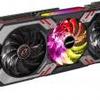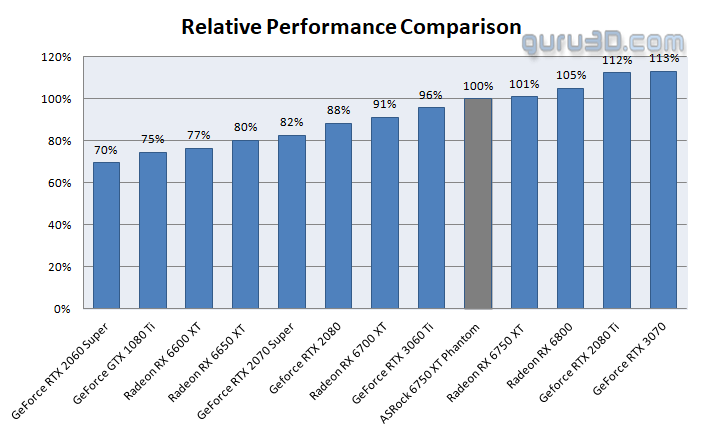Final words and conclusion
Final words
In the games we played, the AMD Radeon RX 6750 XT performed roughly 5 to 10% faster on average. The card's triple-fan cooling system looks attractive and performs well with the Navi GPU. Overall, the Radeon RX 6750 XT is a memorable card for gaming in the WQHD (2560x1440) resolution area, although it is somewhat pricey. In the previous two years, mainstream serials have experienced extraordinary price increases. Out of the box, this performs better than a reference video card; however since AMD is not distributing these for review, it'll be a bit of a wild guess. The mainstream video card is physically larger in every dimension to support the powerful cooling and three-fan architecture. The backplate is adequately vented and provides cooling via thermal pads. It is possible that the standard RX 6750 XT performs similarly to the RTX 3070 Ti and sometimes 3080, but solely in terms of shading performance. Raytracing performance is significantly slower than that of the rivals. Also, this is mainly in the lower resolutions thanks to caching techniques applied. While the Infinity cache works well in most cases, it was designed as a workaround for a flaw in the memory type chosen (GDDR6 versus GDDR6X), and the current AMD GPUs are memory bandwidth constrained, even when using GDDR6 at 18 Gbps, but especially when using a 192-bit wide memory bus. We question AMD's attempt to justify a price of 549 USD, though.
Performance spread reference
We've been fairly busy over the past few weeks or so, with eight Radeon RX 6x50 XT reviews lined up, technically more as we're still waiting on other brand samples as well. Thus, the variances are not enormous from top to bottom; have a look:
So the chart above is arbitrary because results can differ a single % here and there, less so in fillrate limited situations, and more so in GPU bound situations. But from reference to the fastest AIB cards, you're looking at 3 to 4% differentials (depending on game and resolution).
Cooling & acoustic
ASRock performs great. You've seen the FLIR photographs; there is barely any illumination. Expect 65 Degrees C. Temperatures will differ slightly based on chassis and airflow. Regarding acoustics, at 36 DBa under load, we cannot complain.
Energy
Heat output and energy consumption are closely related to each other, as (graphics) processors and heat can be perceived as a 1:1 state; 250 Watts in energy consumption approaches close to 250 Watts in heat as output. This is the basis of TDP. AMD is listing the card at 250W, which is okay at best for a graphics card in the year 2022. We measure numbers slightly above the XT's advertised values; we measure the entire power consumption of the card to close in at ~275 Watt; that's total board power, not TGP (fans and RGB can easily utilize 10~15 Watts). The card can peak to 300W (spikes).
Coil whine
Compared to the reference Radeon RX 6700 XT, the STRIX card exhibits far less coil squeal. It's at a level you can hardly hear it. In a closed chassis, that noise would fade away in the background. However, with an open chassis, you can hear coil whine/squeal. Graphics cards all make this in some form, especially at higher framerates; this can be perceived.
Pricing
AMD has done a great job with NAVI22. However, the price of an entry-level to mainstream graphics card has settled at $ 525-550. The model listed and tested today sits close to RTX 3070 series performance though, but only in shading performance. Raw Raytracing's performance lags behind the competitors.
Tweaking
The RX 6750 XT enjoys having more memory bandwidth available to it. You can add it manually and get up to 18.5; however, results will vary depending on the board, brand, and even card due to cooling (GDDR6/GPU/VRM) and other factors. We could get this AMD Navi GPU to run at a very respectable 2950 MHz with a little GPU tweaking. And that's without any anomalies or crashes of any kind. The dynamic clock frequency is now hovering in the ~2900 MHz range, depending on the load, game/app, and board assigned power. Even so, that's quite a feat. As is always the case, all of your tweaking and increased energy consumption will only provide you with a maximum of ~5% improvement in performance (depending on your results and model graphics card). It must successfully complete four-game runs (in four different games) in 2560x1440 resolution in order to be considered stable enough to be listed here.
Conclusion
This ASRock Radeon RX 6750 XT offers a modest performance boost over the reference Radeon RX 6700 XT we tested last year. Despite having the same number of Raytrace accelerators (40) and Stream Processors (2,560), this jump in performance is the result of an overclocked GPU running at a base clock rate of 2,495 MHz (AMD's default is 2424 MHz) and a Game and Boost clock rate of 2554/2634 MHz, respectively. In addition, you now have access to 12GB of GDDR6 memory operating at a faster memory speed of 18Gbps. All of the increases mentioned above in speed will boost your game performance but do remain a relative perf bump. You will have a WQHD product with excellent performance at temperatures and noise levels that are perfectly acceptable. Aesthetically, the card is handsome, albeit perhaps a bit large. This is a beautiful Full HD and Quad HD card with limited Ultra HD capabilities. The raytracing performance of this generation's RDNA2 GPUs is merely ordinary, while AMD is severely lacking in DLSS. These might be overlooked if the product was reasonably priced, but since the card will likely cost well over 600 USD/EUR, we cannot rationalize such a price point. This is not ASRock's fault; AMD has priced this series excessively. Nonetheless, the design is exquisite, with all the necessary boxes checked. If you're looking for a solid 1440p graphics card, and ASRock can keep the price of their Radeon RX 6750 XT Phantom Gaming close but not above MSRP, then you should consider it. The overclocked GPU and 18Gbps GDDR6 RAM help it perform somewhat better than, say an RX 6700 XT.
Sign up to receive a notification when we publish a new article.
Or go back to Guru3D's front page.
- Hilbert, LOAD"*",8,1.


